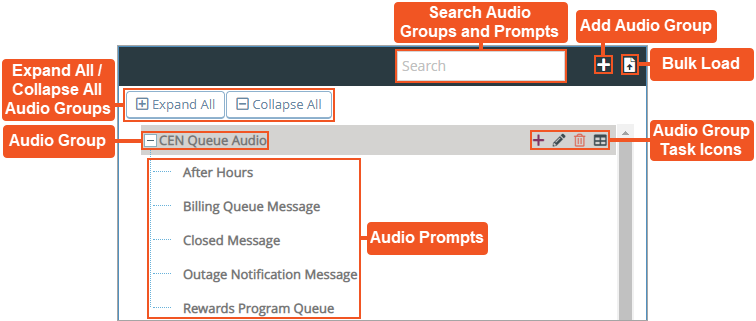Topic Updated: April 01, 2025
Audio Manager Features
Audio Manager provides users with features for easy management of audio files used within the contact center. It consists of the following two panes:
- Audio Groups Pane - Contains the list of all available Audio Groups and Audio Prompts and displays them within a tree structure. In this pane, users can:
- Add/edit/delete/audit Audio Groups
- Add Audio Prompts
- Search both Audio Groups and Audio Prompts
- Audio Files Pane - Displays audio files associated with the Audio Prompt selected in the Audio Groups Pane. In this pane, users can:
- Add/edit/delete selected Audio Prompt
- Add languages
- Add audio files
- Play Audio files
- Activate/deactivate audio file versions
- Name audio file versions
Using the Audio Group Pane
Search Audio Groups and Prompts – Search field used to quickly find a specific Audio Group, Audio Prompt. Search results also include codes and prompt IDs. To search, enter text into this field, and press the Enter or Return key on the keyboard.
Add Audio Group – Allows a user to add a new Audio Group.
Bulk Load – Opens the Audio Bulk Load dialog allowing an internal user to create audio groups and prompts in bulk.
Expand All – Expands all Audio Groups to reveal their contained Audio Prompts.
Collapse All – Collapses all Audio Groups to hide their contained Audio Prompts.
Audio Group – Groups similar Audio Prompts together. Clicking the Plus (+) or Minus (-) icon next to an Audio Group expands or collapses that groups Audio Prompts.
Audio Group Task Icons – Icons used to perform various tasks for managing Audio Groups. The task icons allow users to perform the following tasks:
- Add Prompt – Add a new Audio Prompt to the Audio Group.
- Edit Audio Group – Edit the Audio Group information.
- Delete Audio Group – Delete the Audio Group from the list.
- Audit Audio Group – View the detailed history of changes made to the Audio Group.
Audio Prompts – Audio Prompts describe the type of audio files contained within. Selecting an Audio Prompt displays the audio file information in the Audio Files Pane.
Using the Audio Files Pane
Audio Prompt Task Icons – Icons used to perform various task for managing Audio Prompts. The task icons allow users to perform the following tasks:
- Add Language – Add a new language to the Audio Prompt.
- Edit Prompt – Edit the Audio Prompt information.
- Delete Audio Prompt – Delete the Audio Prompt from the list below the Audio Group.
Language Drop-down Menu – Allows for the selection of which language to display audio files for the prompt.
Schedule Audio File – Schedule audio file activation date and time. See the icon color descriptions below:
- If the Schedule Audio File icon is gray, the audio prompt does not contain any audio files.
- If the Schedule Audio File icon is dark gray, you can click the icon to create a schedule.
- If the Schedule Audio File icon is green, the schedule is active.
- If the Schedule Audio File icon is red, the schedule has completed.
Audio Versions – Lists of all audio files contained within the Audio Prompt. Here, users can name each audio file, and perform the following actions:
- Play Audio – Plays the audio file.
- Upload File – Replaces the audio file.
- Activate Version – Sets the audio file as active.
- Deactivate Version – Sets the audio file as deactivated.
- Download Audio File – Downloads the audio file.
- Remove File – Deletes the audio file. (This icon is not available for the currently activated audio file.)
Add Audio File Button - Allows a user to add a new audio file to the Audio Prompt.
NOTE:
To learn more about audio files/versions, see Working with Audio Versions.
See Also
Please let us know how we can improve this topic by clicking the link below:








